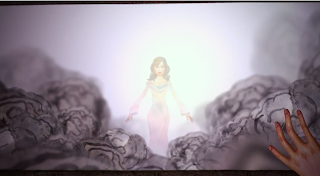The short film “when you find me”, by Ron Howard, is the
product of the photos taken for the Long Live Imagination contest, which asked
people everywhere to take photographs that exemplified the 10 themes of
storytelling. Ron Howard sought to implement these ten themes in his film. In
this blog post, I will analyze the elements in this production that show these
themes.
Let’s start off with the theme of the Unknown. In the short
beginning scene, you really aren’t given any context at all concerning what is
happening. While that is sort of understandable, the prevalence of white
coloring is disconcerting; making you wonder what exactly is happening. This
sort of setting isn’t exactly grounded in reality after all. Secondly, most of
the scene focuses on the tree and the girl, hinting at some importance to them.
As we find later in the film, this is indeed the case.
The next scene establishes a Character. By focusing on the
woman’s movement and actions instead of the boy or the husband, they are
highlighting her importance. The darkness and tone of her words also work
towards giving her a very gloomy attitude, and the way she talks to her son
implies an importance in whatever happened to her and her sister.
Cut to: Backstory. While these next few scenes are a major
portion of the film, they are an explanation of present events, notably the
relationship between the woman and her sister. The way the camera is already
focused on the little girl in the beginning of the above scene, it immediately
shows us that this person is related to or is in fact the woman from the
previous scene. More to the point, the sudden change in scenery and time is
Howard’s way of telling us that this scene is going into further detail
concerning woman and her sister, and what causes the tension between them.
At this point in the movie, the theme of Discovery becomes
especially critical. The death of the girls’ mother is a pivotal moment, and
sets the tone for the evens that follow.
The flow in time is shown in the following scene, through
the use of a shot of the sun lower in the sky, and the darker atmosphere that
comes with it. The body language of the girls implies that a very short time
has passed since the death of their mother, and their position in the
background exaggerates the loss and loneliness they feel.
Ah, and then there is the Goal. The cartoonish feel of this
scene is used to showcase the little girl’s imagination, and the way in which
she views her desire to see her mom.
Next up is the Obstacle. The gate is shown as large and
imposing in contrast to the girls to show the impossibility of the little
girl’s desire to see her mother, and gives the older girl a chance to emphasize
that. Of course, it could be just a gate. I wouldn't be able to climb one even if I tried. But enough of that.
In the diner scene, the Mood in is palpable, as well as the Relationship
between the two sisters. By giving a good view of both their faces, you are able
to see the tension that is right beneath the surface. The lighting also plays a part, giving it all a very tiring and depressing feel.
Lastly, there is Setting. After all the other scenes, we are finally shown the meaning of the very first. The ethereal quality given to the field emphasizes the other-worldliness and unreal atmosphere of it. It is clear (or perhaps not clear at all) that it represents heaven in some form, what with the mothers presence below the tree.









No comments:
Post a Comment